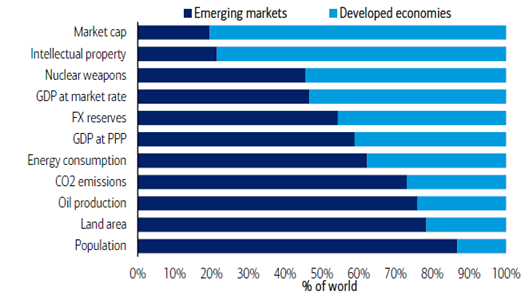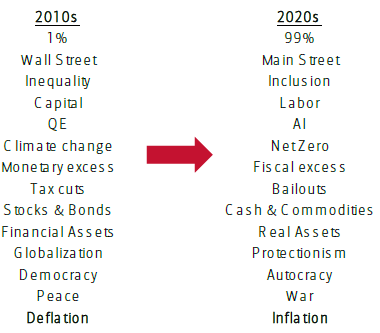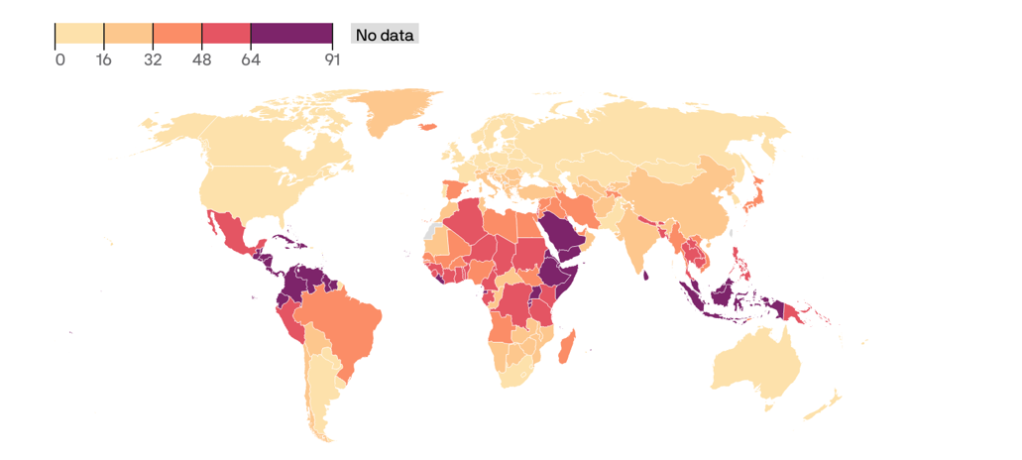Globally, our collective net worth is estimated to be $454 trillion according to the 2023 UBS Global Private Wealth report, of which approximately $110 trillion is the aggregate value of all stock markets around the world. The battle over how that value is divided, utilized, and deployed is arguably a significant contributor to the dramatic polarization we now see every day.
The level of global debt, which as of 2Q23 was $307 trillion according to the Institute of International Finance, further exacerbates these tensions. Global debt has increased by approximately $100 trillion over the last ten years and now stands at 336% of global GDP. This burden puts significant pressure on future investments as interest payments crowd out more productive uses for that capital.
Polarization is evident across three principal vectors. The tension between the developed and emerging economies is staggering. The political divide between democratic and autocratic systems of government is creating immediate existential risks to world order. Geographic polarization is driven by climate change (and in some cases, unfortunate climate policies) creating challenges to reliable access to food and clean water, which often mirrors economic divides. These issues also contribute directly to the urgent migration crisis which will continue to create profound and long-lasting schisms between us all.
Primal anxieties and fears likely contribute to this polarization. Deep-seated concerns about access to sufficient financial resources, nourishment, and healthcare for oneself and family are threats that trigger a cascade of extreme apprehensions. Accelerated rates of change directly contribute to heightened polarization. As an investor in healthcare technology, my focus is on the role innovation might play in chipping away at some of these challenges. Advances in digital health should extend world-class care to those least able to access it. I continue to remain hopeful – if we are afforded enough time.
Fundamental premise: our collective well-being is a function of the well-being of the most disadvantaged among us; that is, disparity in and of itself contributes to worse overall outcomes. Therefore, polarization, in whatever form it may take, hurts us all. Robust safety nets and strong functioning democracies help to level the field and improve the condition of those least fortunate, which benefits us all. It also facilitates more productive allocation of capital.
One informative benchmark is life expectancy. Globally, it is now 73.4 years according to the United Nations Population Division. Hong Kong, somewhat surprisingly as someone who grew up there, enjoys the highest at 85.8 years, while tragically Chad comes in last at 53.7 years. According to Statista, life expectancy in the least developed countries is 62 years for males and 67 years for females. The United States ranked #47 overall at 79.7 years.
Undoubtedly, emerging markets (“EM”) are increasing in importance and influence, largely given the size of their populations and ownership of critical natural resources. A recent World Bank study concluded that EM represents 87% of the world’s population and yet only ~20% of global net worth. More than 75% of the world’s oil supply is in the EM, and alarmingly, nearly half of the nuclear weapons are in EM countries. A March 2023 UBS study concluded that the EM spend 5.2% of GDP on healthcare as compared to ~18% in the U.S. This broad level of disparity is not sustainable and will contribute to a “revolution of rising expectations” (see Harland Cleveland’s work during the Cold War).
Source: World Bank
A recent Goldman Sachs EM market capitalization forecast concluded that by 2030 EM will be 35% of global market value and by 2075 it will 55%. The analysis concludes that the U.S. share of global GDP will decline from 42% today to 27% in 2050 and 22% by 2075. China will increase from 10% today to 15% in 2050, and interestingly, will then start to decline to 13% by 2075 due to declining population growth. India is expected to increase from ~2% today to 12% by 2075. Global, U.S. and EM GDP growth in 2024 are projected to be 2.8%, 1.1% and 4.2%, respectively.
Bank of America translated this polarization into how it has changed investment themes over the last decade. Obviously, the pandemic with the associated economic fallout (dramatic fiscal stimulus, rising interest rates, etc) and the wars in Ukraine and now Israel have all contributed to a move from globalization to isolationism with a greater emphasis on labor versus capital. Interestingly, a recent Financial Times analysis showed that developed economies reached the highest level of employment in 2Q23 at above 70%, with a record high of workforce participation at 73.7%. The concatenation of these various events makes effective policy decisions near-impossible.
Source: Bank of America
Confoundingly, the U.S. spends nearly $12.6k annually per capita on healthcare which is twice as much a majority of other developed countries, and yet, it is believed that outcomes are 20-30% less, according to a 2023 analysis by the Peter G. Peterson Foundation. KFF (formerly the Kaiser Family Foundation) recently published its Employer Benefits Health Survey showing that the average annual premium for employer-sponsored health insurance for a family was nearly $24k in 2023. Clearly, the U.S. healthcare system is fraught with waste and abuse given the lack of productivity.
There is one group of people who confronts a common set of issues which cuts across all strata of society, and that is the 16% of the world’s population who live with a physical and/or mental disability. While 24% of these 1.3 billion people live below the poverty line according to the McKinsey Health Institute, those with disabilities tend to be marginalized wherever they reside. Approximately half of those over 60 years old have a disability, while 19% of women and 12% of men are thought to be disabled to some degree. The incidence of disabilities is twice for those who are displaced when compared to the local population.
Rapid climate changes are driving greater and disruptive migration, further burdening local communities, and inflaming great polarization. An analysis by Climate Central (below) determined the number of days this year that extreme temperatures were at least 3x more likely on any given day, making quite clear that the EM countries faced the greatest climate risk, often pushing people to migrate north/south away from the equator. Central America and Africa saw 2-3 months of extreme high temperature risks. EM countries account for roughly 75% of all carbon dioxide emissions.
Source: Climate Central
In addition to the devastating crisis in Ukraine which has disproportionately hurt the EM countries given their reliance on grains from that country, there are other implications from disparities of wealth as it informs access to quality food. Many regions of the world can no longer support productive farming.
Embarrassingly, a recent U.S. Agriculture Department report concluded that 31% of all food in the U.S. goes uneaten, mostly attributed to the often misleading or misunderstood “sell by date” labelling. It is estimated that 43 billion pounds and 90 billion pounds of food is wasted by retailers and consumers, respectively. This lost food represents 387 billion calories or the equivalent of 1,250 calories per American daily. World Vision estimates 828 million people (~10% of the world’s population) go to bed hungry every day.
Obviously, the United States enjoys extraordinary largess and good fortune. Total American salaries this year will be $11.8 trillion according to the U.S. Bureau of Economic Analysis. Sadly, women compromise nearly 46% of the U.S. workforce yet only make 85% of their male counterparts. According to the Federal Reserve the median U.S. household had a net worth of $192.7k (below), which was in large measure due to the extraordinary government fiscal and monetary policies to support Americans at the outset of the pandemic, and that 58% of all households now have stock holdings. The personal savings rate spiked to 33.8% in April 2020, and while it retreated to 3.5% in 2022, this year it is 4.3% according to analysis by Goldman Sachs. It is estimated that savings and cash on-hand at U.S. households is $16.8 trillion or ~5% of GDP.
Source: Federal Reserve
The Congressional Budget Office estimates the federal deficit is now $1.7 trillion, not including the approximately $300 billion of potential student loan debt cancellations. Frustratingly, the Internal Revenue Service recently estimated that there was $688 billion of unpaid taxes in 2021 (which may end up being closer to $625 billion once those scofflaws are pursued) for a compliance rate of 86.3%. The magnitude of this lost revenue ranks between Taiwan and Belgium’s GDP and would be the 23rd largest country. One would hope that there would be a greater level of gratitude and that all would be compliant and pay it forward.
So, as remarkable as our economy, political system, and our fortunate geography are, the country confronts profound polarization along nearly every dimension. Fundamentally, advances in healthcare technology should ameliorate some of these tensions as even the most disenfranchised should be able to access low-cost quality healthcare that will meet them where they are.





great article, thanks for sharing. shocking and sad, but makes me optimistic that small but meaningful advances in healthcare will continue to help close these gaps and achieve greater equity across the world.